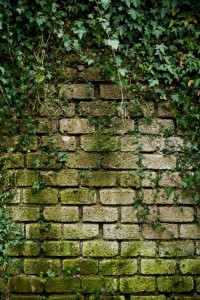Vines, ivy, and other climbing plants are often seen as a charming way to add character to a home’s exterior. However, many homeowners do not realize that these plants can cause serious problems to the masonry underneath them.
How vines harm masonry
While climbing vines might seem like an easy way to add interest or spruce up your chimney, they can actually do more damage than good. The following are just some of the ways that vines can cause problems for your chimney.
- Insects: The leafy foliage of climbing vines provides the perfect hiding place for bugs and insects. With shade, water, and access to food, the vines on your chimneys exterior are irresistible to many insects. Unfortunately, this also gives bugs direct access to your home. Insects can crawl through cracks in the masonry to get inside; likewise, bugs like termites can use the vines as a way to travel directly to wood siding or trim.
- Tendrils and roots: Whether they’re growing on siding or masonry, the tendrils of climbing vines have to stick to something as they grow. When growing on chimneys, the shoots, roots, and tendrils from climbing plants can easily force their way into the masonry, creating cracks, chips, and holes. Masonry joints are particularly susceptible to damage from tendrils and roots; left unrepaired, this can cause damage to the stability of the chimney structure.
- Trapped moisture: When covered in a thick layer of leaves, moisture from dew, rain, snow, and even sprinklers and hoses can become trapped against the masonry. With plenty of shade caused by branches and leaves, much of the water may not evaporate. The presence of water, coupled with the damage to the masonry caused by the climbing roots and tendrils, can seriously damage the masonry.
Removing vines
Although climbing vines look beautiful, there can be trouble lurking underneath them. In addition to damaging your chimney, they can also damage other building materials including wood, gutters, trim, shingles, and even vinyl siding. Because of this, it is recommended to remove vines as soon as possible in order to repair any damage that has occurred as well as prevent future deterioration.
The best way to remove vines is by cutting off the base of the plants at the roots. Doing this stops the plant from growing further, allowing shoots, tendrils, and leaves to dry and fall away. It is important to allow as much of the vines to fall away on their own as possible; pulling on branches or tendrils, especially those that have been growing for years, can actually cause more damage to the underlying masonry. Bricks and mortar that have been weakened by climbing plants can completely fall and break away if the vines are harshly pulled away.
While climbing plants, flowers, and vines add character to the outside of your home by covering your chimney structure, they may be hiding – or causing – serious underlying damage. To keep your chimney in the best condition possible, remove vines and have the damage repaired as soon as possible.
